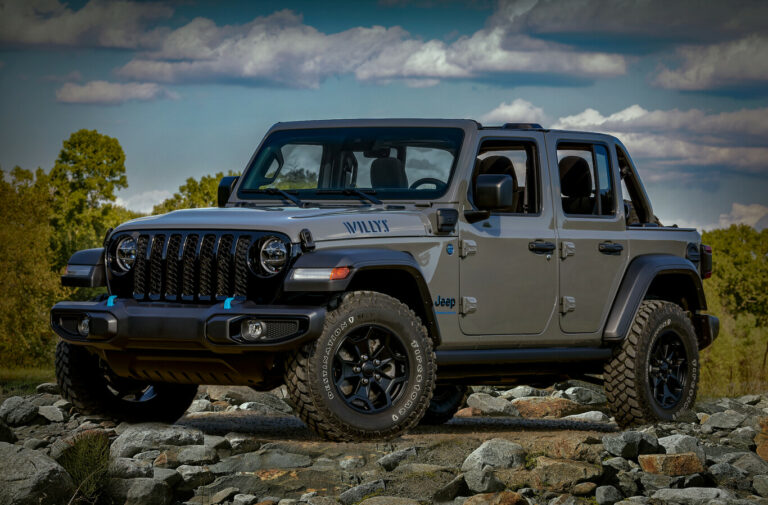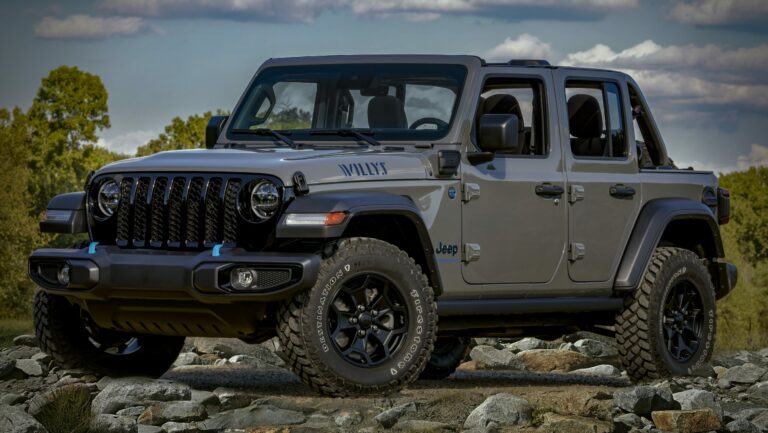1988 Jeep Grand Wagoneer For Sale: A Comprehensive Buyer’s Guide
1988 Jeep Grand Wagoneer For Sale: A Comprehensive Buyer’s Guide jeeps.truckstrend.com
In an automotive landscape increasingly dominated by sleek, modern SUVs, there remains a persistent and undeniable allure for the classics. Among them, few command as much respect and nostalgia as the Jeep Grand Wagoneer. More than just a vehicle, the Grand Wagoneer, particularly the highly sought-after 1988 model, represents an era of rugged luxury, blending the utilitarian spirit of a Jeep with the comfort and prestige of a family wagon. Often credited as the "original luxury SUV," its iconic woodgrain paneling, commanding presence, and robust V8 engine have cemented its place in automotive history and continue to draw enthusiasts and collectors alike.
For those considering adding this venerable classic to their garage, navigating the market for a 1988 Jeep Grand Wagoneer For Sale requires knowledge, patience, and a keen eye. This comprehensive guide aims to equip prospective buyers with the insights needed to make an informed decision, ensuring that the dream of owning a piece of American automotive heritage becomes a rewarding reality.
1988 Jeep Grand Wagoneer For Sale: A Comprehensive Buyer’s Guide
The Enduring Allure of the 1988 Grand Wagoneer
The 1988 model year falls near the end of the Grand Wagoneer’s original, remarkably long production run (1963-1991), making it one of the most refined and feature-rich iterations of the SJ platform. By ’88, the formula was perfected: a powerful AMC 360 cubic inch (5.9L) V8 engine, a smooth TorqueFlite 727 automatic transmission, and Jeep’s legendary Selec-Trac NP229 transfer case offering both full-time and part-time four-wheel drive.
But it’s not just the mechanicals that captivate. The Grand Wagoneer’s distinctive styling, characterized by its prominent chrome grille, square headlights, and the unmistakable simulated woodgrain paneling, evokes a sense of timeless Americana. Inside, buyers were treated to plush leather or velour upholstery, power everything (windows, locks, seats), air conditioning, and a level of comfort not typically associated with a vehicle of its off-road pedigree. Its robust, body-on-frame construction and solid axles provided a comfortable, if somewhat floaty, ride, along with impressive capability, making it equally at home on a suburban street or a rugged trail. This unique blend of luxury, utility, and unmistakable character is precisely why the 1988 Grand Wagoneer remains a highly coveted classic.
What to Look For: Key Inspection Points
Purchasing a 35-year-old vehicle, even one as well-built as the Grand Wagoneer, requires a thorough inspection. Knowing common problem areas can save significant time and money in the long run.
A. Mechanical Condition
- Engine (AMC 360 V8): These engines are generally robust but can be prone to oil leaks (valve covers, oil pan, rear main seal). Check for excessive smoke from the exhaust, unusual noises (knocks, ticks), and proper idle. A compression test is highly recommended. Pay attention to the cooling system (radiator, hoses, water pump) and the carburetor, which can often be finicky and require rebuilding or tuning.
- Transmission (TorqueFlite 727 Automatic): Inspect the fluid for color and smell (burnt fluid indicates issues). Test all gears, including reverse, ensuring smooth, consistent shifts without harshness or slipping.
- Transfer Case (Selec-Trac NP229): Verify that the 2WD, 4WD High (full-time and part-time), and 4WD Low settings engage properly. Listen for grinding or clunking noises. The vacuum lines controlling the front axle disconnect (CAD) are common failure points.
- Suspension & Steering: Check for worn bushings, ball joints, tie rod ends, and leaf springs. A common issue is play in the steering box, leading to a loose steering feel. Look for leaky shocks.
- Brakes: The 1988 model typically features front disc brakes and rear drum brakes. Test the pedal feel (should be firm) and check for pulling or pulsating. Inspect brake lines for rust.


B. Body and Frame
- Rust: This is the Grand Wagoneer’s Achilles’ heel. Common rust spots include the rocker panels, lower fenders, tailgate (especially around the window), floorboards, and frame rails (particularly near the leaf spring mounts). A thorough underneath inspection is crucial.
- Woodgrain Paneling: While iconic, the simulated woodgrain vinyl often fades, cracks, peels, or warps over time. Replacing it is possible but can be costly. Assess its condition and factor it into your budget.
- Paint: Original paint can show its age with fading or clear coat peel. Look for signs of poor-quality repaints, such as overspray or mismatched colors.
- Glass and Seals: Check for cracked glass and deteriorated weather stripping around windows and doors, which can lead to leaks.
C. Interior
- Upholstery: The leather or velour seats are prone to cracking, tearing, and fading, especially on the driver’s side.
- Headliner: Sagging headliners are almost universal in Grand Wagoneers of this era.
- Dashboard: Cracks in the dash pad are common due to sun exposure.
- Electronics: Test all electrical components. The power windows are notorious for slow operation or failure due to worn motors and regulators. Check the power locks, radio, gauges, and especially the air conditioning system (often inoperative).
- Carpeting: Look for tears, stains, and signs of water intrusion beneath the carpets, which could indicate leaks or previous rust issues.
Understanding the Ownership Experience
Owning a 1988 Grand Wagoneer is a unique experience, distinct from modern vehicles.
A. Maintenance & Parts Availability
Fortunately, parts availability for the AMC 360 engine and TorqueFlite 727 transmission is generally good due to their widespread use in other Jeeps and Chrysler products. Many common mechanical components are still reproduced or readily available from specialized vendors. However, specific trim pieces, interior components, and electrical parts unique to the Grand Wagoneer can be harder to source and more expensive. Be prepared for regular maintenance and the occasional unexpected repair; this is not a low-maintenance vehicle.
B. Fuel Economy
Let’s be realistic: the 1988 Grand Wagoneer is not fuel-efficient. With its carbureted V8 and significant weight, expect average fuel economy to be in the range of 10-14 miles per gallon (MPG), depending on driving conditions and vehicle tune. Factor this into your running costs.
C. Driving Dynamics
The Grand Wagoneer offers a classic "truck-like" driving experience. It’s comfortable on the highway, with a soft, compliant ride, but don’t expect nimble handling or quick acceleration. Its high driving position provides excellent visibility, and the V8 offers ample torque for merging and light towing. It’s a vehicle that encourages a relaxed pace and a connection to the road less traveled.
The Buying Process: Tips for Prospective Owners
Finding the right 1988 Jeep Grand Wagoneer For Sale requires a strategic approach.
- Set a Realistic Budget: Beyond the purchase price, budget for immediate repairs, deferred maintenance, and potential cosmetic improvements. A "cheap" Grand Wagoneer can quickly become an expensive project.
- Do Your Research: Familiarize yourself with common issues and typical market values. Online forums and owner groups are invaluable resources.
- Get a Pre-Purchase Inspection (PPI): This is perhaps the most critical step. If you’re not mechanically inclined, hire a trusted mechanic specializing in classic American vehicles or 4x4s to perform a thorough inspection before you commit. This is especially vital if buying remotely.
- Check Documentation: Ask for service records, past ownership history, and any restoration invoices. A well-documented vehicle often indicates a conscientious owner.
- Be Patient: The perfect Grand Wagoneer won’t appear overnight. It’s a niche market, and finding a well-maintained example takes time. Don’t rush into a purchase.
- Consider Your Purpose: Are you looking for a show car, a reliable daily driver, or a project to restore? Your intended use will heavily influence the condition and price point you should target.
Types/Categories of 1988 Grand Wagoneers For Sale
The market for 1988 Grand Wagoneers can be broadly categorized by condition, which directly correlates to price.
- Concours/Show Quality: These are vehicles that have undergone full, meticulous frame-off restorations. They are often in better-than-new condition, with every detail perfected. These command the highest prices.
- Excellent Driver Quality: Well-maintained vehicles that are largely original or have had sympathetic restorations. They are mechanically sound, present very well cosmetically, and are ready to be enjoyed regularly. Minor imperfections might be present.
- Good Driver Quality: These are solid, functional vehicles that might show their age with some cosmetic flaws (faded paint, minor interior wear, woodgrain issues) and perhaps a few non-critical mechanical quirks. They are perfectly usable but aren’t showstoppers.
- Fair Condition/Project Car: These vehicles will require significant mechanical and/or cosmetic work. They might run and drive but have multiple known issues. Suited for enthusiasts with the skills, time, and budget for a restoration.
- Parts Car: Beyond economic repair, these vehicles are primarily valuable for their salvageable components.
1988 Jeep Grand Wagoneer Estimated Price Guide
Please note: These prices are highly variable based on location, mileage, originality, specific features, and the seller’s urgency. This table provides a general range.
| Condition Category | Estimated Price Range (USD) | Key Characteristics |
|---|---|---|
| Concours/Show | $60,000 – $100,000+ | Flawless, fully restored (frame-off), show-ready, often better than new. |
| Excellent Driver | $35,000 – $60,000 | Mechanically sound, excellent cosmetics, minimal flaws, highly original or sympathetically restored. |
| Good Driver | $20,000 – $35,000 | Runs and drives well, presentable but with noticeable wear (faded paint, interior blemishes, minor rust). |
| Fair Condition | $10,000 – $20,000 | Needs significant work (mechanical and/or cosmetic), may have moderate rust, but a solid restoration candidate. |
| Project Car | $5,000 – $10,000 | Runs (maybe), needs major overhaul, extensive rust or significant mechanical issues. |
| Parts Car | Under $5,000 | Not roadworthy, useful only for salvaging components. |
Frequently Asked Questions (FAQ)
Q: Is the woodgrain on the 1988 Grand Wagoneer real wood?
A: No, it’s a simulated woodgrain vinyl applique, a signature styling cue. While durable, it can fade, crack, or peel over time.
Q: Are parts hard to find for a 1988 Grand Wagoneer?
A: For common mechanical components (engine, transmission, drivetrain), parts are generally available. Specialized trim, interior pieces, and certain electrical components can be harder to source but are often available through dedicated Grand Wagoneer parts suppliers or online communities.
Q: What kind of fuel economy can I expect?
A: Don’t expect much. With its carbureted V8 engine and considerable weight, typical fuel economy is in the range of 10-14 MPG.
Q: Is a 1988 Grand Wagoneer reliable enough to be a daily driver?
A: With proper maintenance and addressing common issues, yes, it can be a daily driver for some. However, it’s an old vehicle and will require more attention and preventative maintenance than a modern car. Be prepared for older vehicle quirks and potentially higher running costs.
Q: What are the biggest common issues I should watch out for?
A: Rust (especially in rockers, tailgate, and frame), failing power windows, inoperative AC, and vacuum leaks (affecting 4WD and engine performance) are among the most frequently reported issues.
Q: Can I easily upgrade the engine or add modern features?
A: Yes, many owners perform engine swaps (e.g., modern LS engines) or upgrade components like brakes, suspension, and install modern infotainment systems. This can significantly increase reliability and comfort, but it also adds to the cost and deviates from originality.
Conclusion
The 1988 Jeep Grand Wagoneer is more than just an SUV; it’s a cultural icon, a testament to a bygone era of American automotive design, and a highly capable vehicle that continues to capture hearts. For those seeking a blend of classic charm, rugged utility, and a touch of vintage luxury, the Grand Wagoneer presents an unparalleled opportunity. While finding the right "1988 Jeep Grand Wagoneer For Sale" requires diligence and a realistic understanding of ownership, the rewards of cruising in this distinctive classic are immeasurable. It’s not just a purchase; it’s an investment in a unique driving experience and a piece of history that continues to turn heads wherever it goes.






